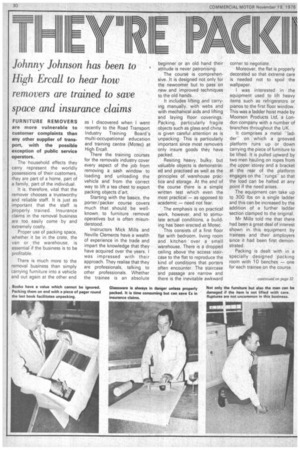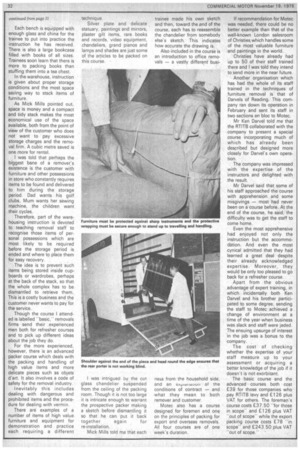Johnny Johnson has been to High Ercall to hear how removers are trained to save space and insurance claims
Page 32

Page 34

If you've noticed an error in this article please click here to report it so we can fix it.
FURNITURE REMOVERS are more vulnerable to customer complaints than any other supplier of transport, with the possible exception of public service operators.
The household effects they carry represent the worldly possessions of their customers, they are part of a home, part of a family, part of the individual.
It is, therefore, vital that the remover chooses a trustworthy and rel.iable staff. It is just as important that the staff is properly trained. Insurance claims in the removal business are too easily come by and extremely costly.
Proper use of packing space, whether it be in the crate, the van or the warehouse, is essential if the business is to be profitable.
There is much more to the removal business than simply carrying furniture into a vehicle and out again at the other end as I discovered when I went recently to the Road Transport Industry Training Board's multi-occupational education and training centre (Motec) at High Ercall.
There the training courses for the removals industry cover every aspect of the job from removing a sash window to loading and unloading the vehicle and from the correct way to lift a tea chest to export packing objects d'art.
Starting with the basics, the porter/packer course covers much that should be wellknown to furniture removal operatives but is often misunderstood.
Instructors Mick Mills and Neville Clements have a wealth of experience in the trade and impart the knowledge that they have acquired over the years. I was impressed with their approach. They realise that they are professionals, talking to other professionals. Whether the trainee is an absolute beginner or an old hand their attitude is never patronising.
The course is comprehensive. It is designed not only for the newcomer but to pass on new and improved techniques to the old hands.
It includes lifting and carrying manually, with webs and with mechanical aids and lifting and laying floor coverings. Packing, particularly fragile objects such as glass and china, is given careful attention as is unpacking. This is particularly important since most removers only insure goods they have packed.
Resiting heavy, bulky, but valuable objects is demonstrated and practised as well as the principles of warehouse practice and storage. At the end of the course there is a simple written test which even the most practical — as opposed to academic — need not fear.
The emphasis is on practical work, however., and to stimulate actual conditions, a building has been erected at -Motec.
This consists of a first floor flat with bedroom, living room and kitchen over a small warehouse. There is a dropped ceiling above the access staircase to the flat to reproduce the kind of conditions that porters often encounter. The staircase and passage are narrow and there is the inevitable awkward corner to negotiate.
Moreover, the flat is properly decorated so that extreme care is needed not to spoil the wallpaper.
I was interested in the equipment used to lift heavy items such as refrigerators or pianos to the first floor window. This was a ladder hoist made by Moorson Products Ltd, a London company with a number of branches throughout the UK.
It comprises a metal "ladderon which a grooved platform runs up or down carrying the piece of furniture to be lifted. It is pulled upward by two men hauling on ropes from the upper storey and a bracket at the rear of the platform engages on the -rungss6 that the load can be halted at any point if the need arises.
The equipment can take up to 300 lbs on a single ladder and this can be increased by the addition of a further ladder section clamped to the original Mr Mills told me that there had been a great deal of interest shown in this equipment by trainees and their employers since it had been first demonstrated.
Packing is dealt with in a specially designed packing room with 10 benches — one for each trainee on the course. Each bench is equipped with enough glass and china for the trainee to put into practice the instruction he has received. There is also a large bookcase filled with books of all sizes. Trainees soon learn that there is more to packing books than stuffing them into a tea chest.
In the warehouse, instruction is given about proper storage conditions and the most space saving way to stack items of furniture.
As Mick Mills pointed out, space is money and a compact and tidy stack makes the most economical use of the space available, both from the point of view of the customer who does not want to pay excessive storage charges and the removal firm. A cubic metre saved is one more for rental.
I was told that perhaps the biggest bane of a remover's existence is the customer with furniture and other possessions in store who constantly requires items to be found and delivered to him during the storage period. Dad wants his golf clubs, Mum wants her sewing machine, the children want their cycles.
Therefore, part of the warehousing instruction is devoted to teaching removal staff to recognise those items of personal possessions which are most likely to be required before the storage period is ended and where to place them for easy recovery.
The idea is to prevent such items being stored inside cupboards or wardrobes, perhaps at the back of the stack, so that the whole complex has to be dismantled to retrieve them. This is a costly business and the customer never wants to pay for the service.
Though the course I attended is labelled "basic," removals firms send their experienced men both for refresher courses and to pick up different ideas about the job they do.
For the more experienced, however, there is an advanced packer course which deals with the packing and handling of high value items and more delicate pieces such as objets d'art. It also involves a code of safety for the removal industry Inevitably this includes dealing with dangerous and prohibited items and the procedure for dealing with vermin.
There are examples of a number of items of high value furniture and equipment for demonstration and practice each requiring a different technique.
Silver plate and delicate statuary, paintings and mirrors, plaster gilt items, rare books and records, video equipment, chandeliers, grand pianos and lamps and shades are just some of the articles to be packed on this course.
I was intrigued by the cut glass chandelier suspended from the ceiling of the packing room. Though it is not too large it is intricate enough to warrant the prospective packer making a sketch before dismantling it so that he can put it back together again for re-installation.
Mick Mills told me that each trainee made his own sketch and then, toward the end of the course, each has to reassemble the chandelier from somebody else's sketch. This indicates how accurate the drawing is.
Also included in the course is an introduction to office removals — a vastly different busi ness from the household side.
and an oIIIUI ot tne conditions of contract — and what they mean to both remover and customer.
Motec also has a course designed for foremen and one on the principles of packing for export and overseas removals. All four courses are of one week's duration. If recommendation for Motec was needed, there could be no better example than that of the well-known London salesroom of Christies which handles some of the most valuable furniture and paintings in the world.
r Christies have already had up to 50 of their staff trained there and I was told they intend to send more in the near future.
Another organisation which has had the whole of its staff trained in the techniques of _furniture removal is that of Darvels of Reading. This company ran down its operation in February and sent its staff in two sections en bloc to Motec.
Mr Ken Daniel told me that the RTITB collaborated with the company to present a special course incorporating much of which has already been described but designed more closely for Daniel's own operation.
The company was impressed with the expertise of the instructors and delighted with the result.
Mr Daniel said that some of his staff approached the course with apprehension and some misgivings — most had never been on a course before. At the end of the course, he said, the difficulty was to get the staff to come home.
Even the most apprehensive had enjoyed not only the instruction but the accommodation. And even the most cynical admitted that they had learned a great deal despite their already acknowledged expertise. Moreover, they would be only too pleased to go back for a refresher course.
Apart from the obvious advantage of expert training, in which incidentally both Ken Darvel and his brother participated to some degree, sending the staff to Motec achieved a change of environment at a time of the year when business was slack and staff were jaded. The ensuing upsurge of interest in the job was a bonus to the company.
The cost of checking whether the expertise of your staff measure up to your assessment or acquiring a better knowledge of the job if it doesn't is not exorbitant.
The basic course and the advanced courses both cost £39 for those companies who pay RTITB levy and £126 plus VAT for others. The foreman's course costs £37.50 "for those in scope" and £126 plus VAT "out of scope" while the export packing course costs £78 ' 'in scope" and £243.50 plus VAT "Out of scope."




































































































